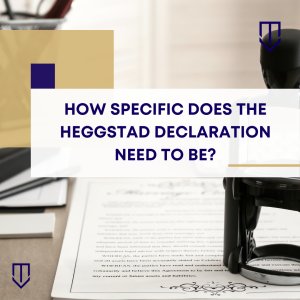 Anytime a litigant wants to file a lawsuit, a threshold question is where the lawsuit should be filed. Specifically, the question is what county should get to hear the action. This process is called determining “venue,” and it can become quite a complicated endeavor. This is because the “correct” county for action will depend on a number of factors.
Anytime a litigant wants to file a lawsuit, a threshold question is where the lawsuit should be filed. Specifically, the question is what county should get to hear the action. This process is called determining “venue,” and it can become quite a complicated endeavor. This is because the “correct” county for action will depend on a number of factors.
One such factor is the “nature” of the action. If it concerns the “internal affairs” of a trust, then specific venue rules come into play. But making this determination isn’t easy. And filing suit in the wrong county could result in both a transfer and sanctions for the plaintiff who didn’t do their homework.
 California Partition Law Blog
California Partition Law Blog


 When a loved one passes away, probate proceedings are hopefully not the first thing on their relatives’ minds. Probate is, however, an inevitability, even when a trust is present and effective. But inheritance is not always the blessing that the public conscious imagines it to be. The simple truth is that owning property in California is an expensive endeavor that carries with it tons of monetary responsibility. Faced with the possibility of inheriting something an individual simply cannot afford, there is an option: a disclaimer of interest.
When a loved one passes away, probate proceedings are hopefully not the first thing on their relatives’ minds. Probate is, however, an inevitability, even when a trust is present and effective. But inheritance is not always the blessing that the public conscious imagines it to be. The simple truth is that owning property in California is an expensive endeavor that carries with it tons of monetary responsibility. Faced with the possibility of inheriting something an individual simply cannot afford, there is an option: a disclaimer of interest.  A Heggstad petition is a unique legal maneuver in probate court that a party can use to establish the existence of a trust. Normally, if a party wants to show that the property at issue is in a family trust, they have to produce evidence of a transfer of the property into the trust. (Prob. Code § 15200 (b).) This is usually accomplished with a deed, which conveys the property from the owners (the “settlors”) to the trustees of the trust.
A Heggstad petition is a unique legal maneuver in probate court that a party can use to establish the existence of a trust. Normally, if a party wants to show that the property at issue is in a family trust, they have to produce evidence of a transfer of the property into the trust. (Prob. Code § 15200 (b).) This is usually accomplished with a deed, which conveys the property from the owners (the “settlors”) to the trustees of the trust.